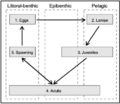Golden galaxias facts for kids
Quick facts for kids Golden galaxias |
|
|---|---|
| Conservation status | |
| Scientific classification | |
| Genus: |
Galaxias
|
| Species: |
auratus
|
The golden galaxias (Galaxias auratus) is a special type of fish. It belongs to a family of fish called galaxiids. This fish is found only in Tasmania, Australia, which means it's endemic to that area. It's known for its beautiful golden color!
Contents
What Does the Golden Galaxias Look Like?
The golden galaxias is a medium-sized fish. It usually grows to about 140 mm (that's about 5.5 inches) long, but some can reach up to 240 mm (almost 9.5 inches). It has a strong body with a long head and a thin snout.
Its upper body and sides are a shiny golden-amber color. You might also see dark oval spots on its sides. The underside of the fish is silvery-grey. Its fins are amber to light orange, with black edges.
Where Does the Golden Galaxias Live?
The golden galaxias lives only in two specific lakes in Tasmania: Lake Sorell and Lake Crescent. It also lives in the streams connected to these lakes. These lakes are located in the Central Highlands region of Tasmania.
Adult golden galaxias prefer to live in shallow parts of the lakes, close to the shore. They like areas with rocky bottoms. These rocks provide safe places for them to hide, lay their eggs, and find food.
Life Cycle and Reproduction
Golden galaxias fish lay their eggs from late autumn to winter. The eggs are quite small, about 1.5 mm across. They stick their eggs to rocky surfaces and underwater plants. They scatter the eggs instead of putting them all in one big clump.
A female fish can lay anywhere from 1,000 to 15,000 eggs! The number of eggs depends on how old and big the female is.
When the eggs hatch, the baby fish are called larvae. They are very tiny, only about 5–6 mm long. These larvae float in the water. As they grow, they become juveniles. Young fish live in open water until they are about 4–5 months old and reach about 40 mm in length. After that, they move closer to the lake bottom near the shore.
Male golden galaxias become old enough to reproduce in their first year, when they are over 50 mm long. Females mature in their second year, when they are over 70 mm long. Most golden galaxias live for about three or four years, but some can live for six years or even longer.
What Do Golden Galaxias Eat?
Like other galaxiid fish, the golden galaxias is an opportunistic carnivore. This means they eat whatever small animals they can find.
Young golden galaxias (juveniles) mostly eat tiny floating organisms called plankton. They also eat small insect larvae that live in the water. Adult golden galaxias have a more varied diet. They eat many different kinds of insects that live in or near the water, as well as snails and small crustaceans (like tiny shrimp).
Why is the Golden Galaxias Endangered?
The golden galaxias is listed as an Endangered species. This is because it lives in a very small area, only about 76 square kilometers. It is also listed as Rare under Tasmanian laws.
The main threats to the golden galaxias are that its habitat is shrinking and becoming less healthy. This means there are fewer places for them to live and thrive.
Images for kids







